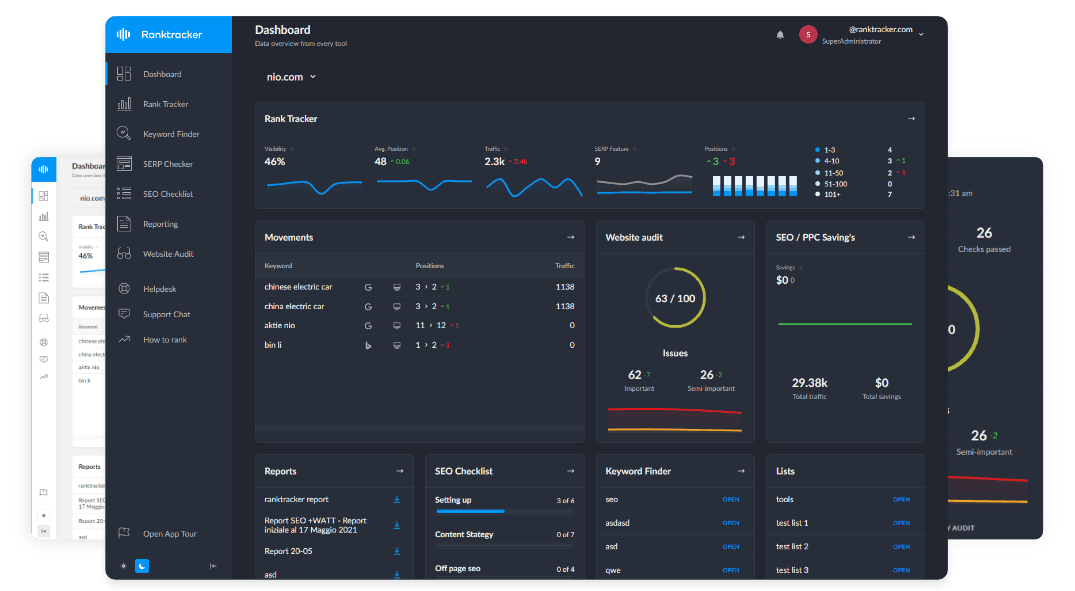Intro
Powerlifters don’t look for “just any gym.” They want a place with proper racks, serious coaching, and a no-BS training environment. These lifters are searching terms like “powerlifting gym near me” or “gyms with deadlift platforms,” and if your gym isn’t ranking, they’re joining your competitor.
With the right SEO strategy and Ranktracker’s all-in-one toolset, your powerlifting gym can claim top spots in Google, reach dedicated strength athletes, and build a thriving community that’s as strong online as it is on the platform.
Why SEO Is Critical for Powerlifting Gyms
Unlike general fitness centers, powerlifting gyms attract a very specific crowd—people who know what they’re looking for. SEO helps you target those high-intent lifters and stand out from cookie-cutter commercial gyms.
SEO helps your gym:
-
Rank for niche and equipment-specific search terms
-
Attract serious lifters looking for competition prep, coaching, or 24/7 access
-
Promote specialty services like meet prep, form coaching, and strength programming
-
Build trust with authentic content, reviews, and athlete highlights
Use Ranktracker’s Rank Tracker to monitor your performance across core niche terms and location-based keywords.
Keyword Research: Target Lifters, Equipment, and Location
You’re not competing with yoga studios—you’re targeting lifters who Google “deadlift bar gym [city]” or “powerlifting coaches near me.”
Use Ranktracker’s Keyword Finder to uncover terms like:
-
“powerlifting gym near me”
-
“strength gym with squat racks [city]”
-
“deadlift-friendly gym [city]”
-
“powerlifting gym with competition equipment”
-
“gyms with kilo plates and calibrated racks”
-
“beginner powerlifting program [location]”
-
“powerlifting meets in [city]”
-
“female-friendly powerlifting gyms”
Segment keywords by:
-
Location: city, zip code, surrounding towns
-
Experience level: beginner, intermediate, competitive
-
Equipment: deadlift platforms, monolifts, calibrated plates
-
Services: coaching, programming, competitions, open gym
On-Page SEO: Convert Passionate Lifters with Precision Pages
Your website should speak directly to lifters, coaches, and athletes—not general gym-goers.
On-page SEO essentials:
-
Title tag: “Top Powerlifting Gym in [City] | [Gym Name] Strength Facility”
-
H1: “Train for Strength. Compete with Confidence.”
-
URL structure:
/powerlifting-gym-[city]/ -
Facility pages:
/equipment/,/coaching/,/meet-prep/ -
Keyword-rich content highlighting equipment, competition setup, and coaching staff
-
Testimonials from local powerlifters or competition success stories
-
CTAs: “Book a Tour,” “Join the Team,” “Schedule a Technique Session”
-
Structured data: LocalBusiness, Review, Event
Preview SERP appearance with Ranktracker’s SERP Simulator.
Local SEO: Become the Strongest Gym on the Map
Local SEO puts you in front of lifters nearby who are actively searching for a serious place to train.
Optimize your local presence by:
-
Claiming and fully filling out your Google Business Profile
-
Using high-quality images of your gym, equipment, and lifters in action
-
Posting regularly: meet results, coaching tips, new equipment
-
Getting consistent NAP (Name, Address, Phone) citations
-
Asking for Google reviews from long-time members and athletes
-
Adding service area pages for nearby cities or counties
Track local visibility with Ranktracker’s Local SEO module.
Content Marketing: Share the Knowledge, Build Authority
Powerlifters crave information. By creating targeted blog and video content, you position your gym as an authority—not just a facility.
The All-in-One Platform for Effective SEO
Behind every successful business is a strong SEO campaign. But with countless optimization tools and techniques out there to choose from, it can be hard to know where to start. Well, fear no more, cause I've got just the thing to help. Presenting the Ranktracker all-in-one platform for effective SEO
We have finally opened registration to Ranktracker absolutely free!
Create a free accountOr Sign in using your credentials
Content ideas for powerlifting gym blogs or videos:
-
“How to Choose the Right Squat Variation for Your Body Type”
-
“Deadlift Technique Fixes for Common Mistakes”
-
“Powerlifting Programming for Beginners: What to Know”
-
“How to Prep for Your First Powerlifting Meet”
-
“Spotlight on Our Team: Meet the Coaches”
-
“Top 5 Mobility Drills for Stronger Lifts”
-
“The Difference Between Strength Gyms and Commercial Gyms”
Use Ranktracker’s AI Article Writer to create expert content efficiently.
Technical SEO: Ensure Fast Loads for Heavy Traffic
Strength athletes have high expectations for performance—your website should too.
Technical SEO must-haves:
-
Mobile optimization for users searching on the go
-
Fast page speed (no lag between lifts or clicks)
-
Clear navigation to key pages: schedule, pricing, equipment
-
Secure HTTPS connection
-
Schema for events (meets), reviews, and local business info
-
Fix crawl issues and optimize alt tags for equipment images
Run a full site checkup with Ranktracker’s Web Audit to stay in peak SEO shape.
Visual SEO: Show Off the Gym, the Team, and the Lifts
Powerlifters want to see where they’ll train and who they’ll train with. Let your images build trust and hype.
Visual SEO strategy for powerlifting gyms:
-
File names:
deadlift-platform-powerlifting-gym-boston.jpg -
Alt text: “Athlete deadlifting at Boston powerlifting gym with calibrated plates”
-
Gym tour videos and lift highlight reels
-
Staff bios with photos of coaches in action
-
Member spotlights: PRs, meet results, training progress
-
Social content reposts and meet recap visuals
Optimize every media file with Ranktracker’s Web Audit to avoid slowdowns.
Link Building: Earn Authority in the Strength Community
Backlinks from reputable strength and fitness sites boost rankings and establish your gym as part of the lifting ecosystem.
Link-building tactics:
-
Submit to strength gym directories
-
Partner with lifting brands, coaches, or influencers
-
Get featured on local sports news or fitness podcasts
-
Host sanctioned meets or seminars and promote them via event pages
-
Publish educational guides that others link to (e.g., “How to Wrap Knees for Squats”)
Track backlinks and identify new opportunities with Ranktracker’s Backlink Monitor.
Social Proof & Reviews: Use Results to Drive Reputation
People trust lifters, not marketing. Let your members speak for your gym.
Strategies to grow your reputation:
-
Display reviews on your homepage and pricing page
-
Use before/after and PR highlight videos
-
Add testimonial banners: “I added 100lbs to my total in 6 months at [Gym Name]”
-
Ask members to review your gym after a meet or milestone
-
Highlight community success in email marketing and social
Monitor your reputation with Ranktracker’s Reputation Management features.
Powerlifting Gym SEO Checklist
-
Target powerlifting-specific and location-based keywords
-
Optimize Google Business Profile and get consistent citations
-
Build service pages for coaching, equipment, and programming
-
Create educational content for lifters at every level
-
Optimize site speed, mobile usability, and crawl structure
-
Use real imagery and video to show lifts, coaches, and community
-
Build backlinks from strength-focused websites and partners
-
Collect and showcase lifter testimonials and reviews
-
Track rankings and content success with Ranktracker’s suite
Conclusion
Powerlifting SEO isn’t about flashy gimmicks—it’s about relevance, authority, and visibility where it matters most. With Ranktracker, your gym can out-lift the competition in search results, attract committed lifters, and build a brand as strong as your community. Show them the plates—and let your SEO pull its weight.

